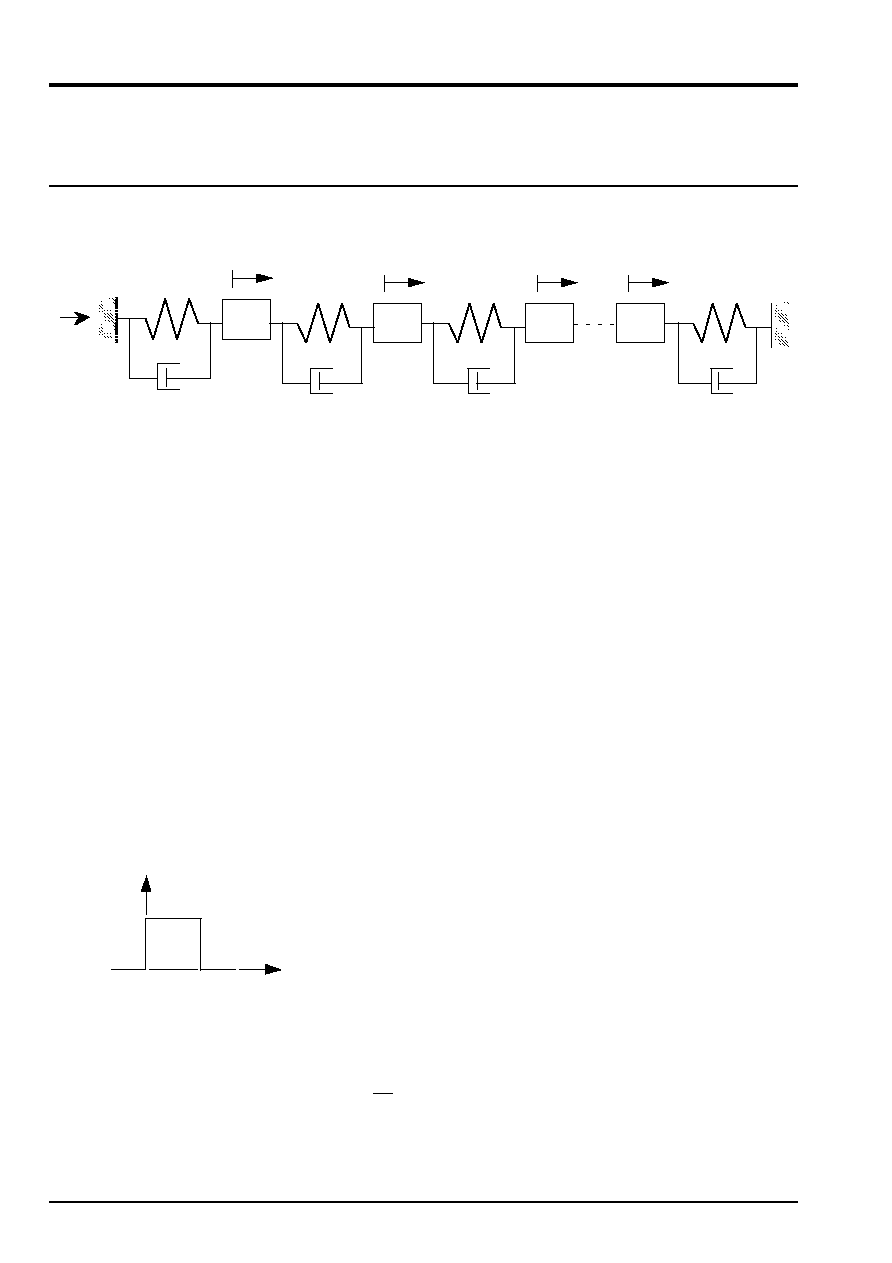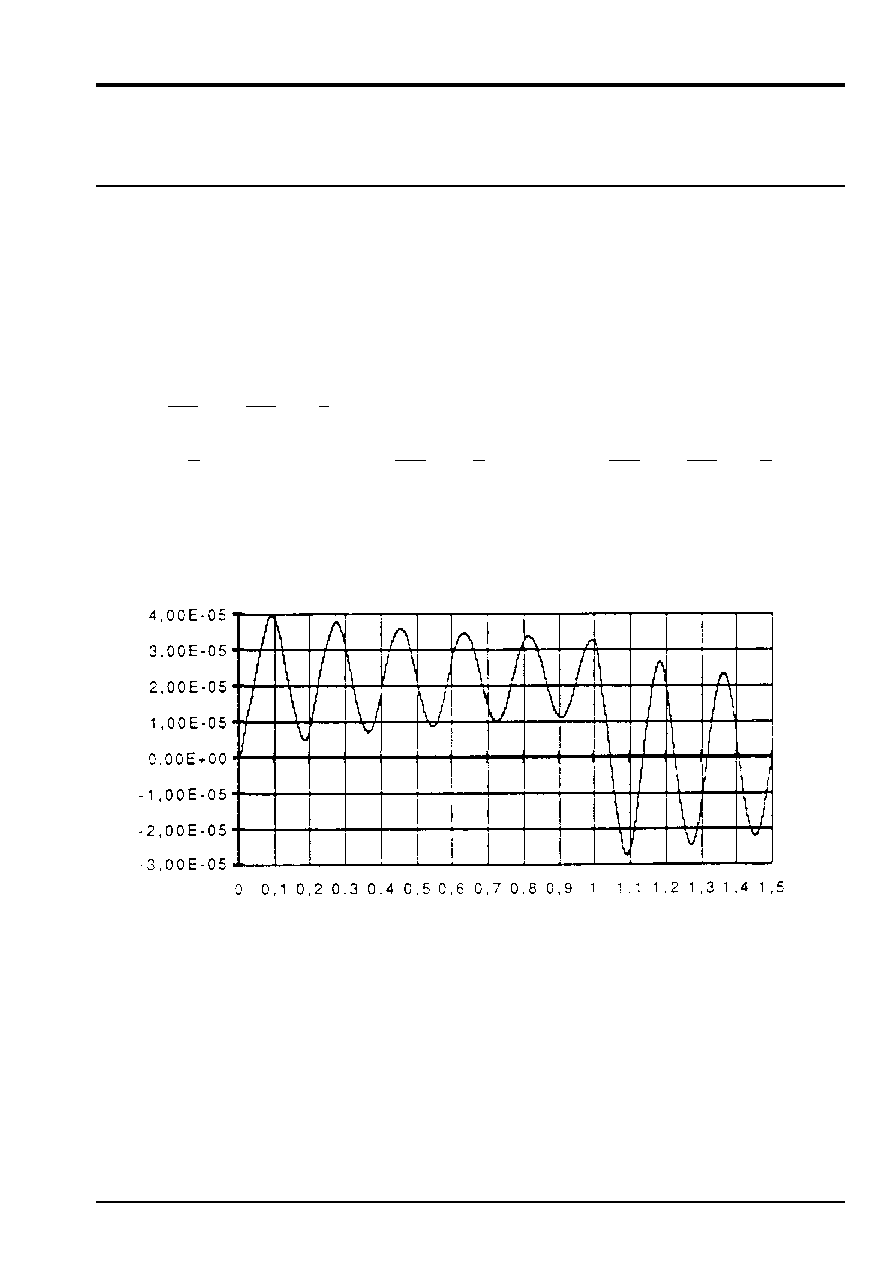
Code_Aster
®
Version
4.0
Titrate:
SDLD29 Transitoire masses spring with 8 ddl
Date:
01/12/98
Author (S):
A.C. LIGHT
Key:
V2.01.029-C
Page:
1/6
Manual of Validation
V2.01 booklet: Linear dynamics of the discrete systems
HI-75/98/040 - Ind A
Organization (S):
EDF/EP/AMV
Manual of Validation
V2.01 booklet: Linear dynamics of the discrete systems
Document: V2.01.029
SDLD29 - Transient masses spring with 8 ddl
and viscous damping nonproportional
Summary:
This problem corresponds to a transitory analysis by modal recombination of a linear discrete system
constituted of 8 degrees of freedom. This system has a non-proportional damping. A force
transient of the square pulse type is applied into 1 degree of freedom.
In this problem the elements are tested
DISCRETE
with modal masses (
M_T_D_N
), matrices of rigidity
(
K_T_D_L
) and matrices of damping (
A_T_D_L
) in a modeling.
The problem has a reference solution suggested by commission VPCS. Variations with
Code_Aster
do not exceed 1,8%.

Code_Aster
®
Version
4.0
Titrate:
SDLD29 Transitoire masses spring with 8 ddl
Date:
01/12/98
Author (S):
A.C. LIGHT
Key:
V2.01.029-C
Page:
2/6
Manual of Validation
V2.01 booklet: Linear dynamics of the discrete systems
HI-75/98/040 - Ind A
1
Problem of reference
1.1 Geometry
X, U
m
K
DC
P1
K
C
U
m
P2
m
K
C
P3
U3
U2
1
m
P8
K
Cd
U8
B
With
Specific masses:
m
P1
= m
P2
= m
P3
= ...... = m
P8
= m
Stiffnesses of connection:
K
AP1
= K
P1P2
= K
P2P3
= ...... = K
P8B
= K
Viscous damping:
C
P1P2
= C
P2P3
= ...... = C
P7P8
= C
C
AP1
= DC
C
P8B
= Cd
1.2
Material properties
Comes out from linear elastic translation
K =
10
5
NR/m
Specific mass
m =
10 kg
Damping of connection
C =
50 NR/(m/s)
DC =
250 NR/(m/s)
Cd =
25 NR/(m/s)
1.3
Boundary conditions and loadings
Embedded points A and B:
U
=
0
Loading: Force concentrated not periodical at the P4 point
0
1
T
Fx
4
1
Not P4
Fx
4
= F (T) 0 ² T ² 1s
T > 1s
F (T) = 1N = constant
F (T) = 0
1.4 Conditions
initial
For T = 0, in any point P
I
:
U
=
0, of
dt
=
0
.

Code_Aster
®
Version
4.0
Titrate:
SDLD29 Transitoire masses spring with 8 ddl
Date:
01/12/98
Author (S):
A.C. LIGHT
Key:
V2.01.029-C
Page:
3/6
Manual of Validation
V2.01 booklet: Linear dynamics of the discrete systems
HI-75/98/040 - Ind A
2
Reference solution
2.1
Method of calculation used for the reference solution
Numerical integration (approximate) by the direct method using a diagram of integration
numerical by finished differences, the pitch of time used must be sufficiently small to obtain one
sufficiently precise solution. With one of the diagrams used (method
- Newmark improved), the pitch
appointed time was of 0.001s.
Method of
- Newmark improved (NEWMARK NR. Mr., “A method off computation for structural
dynamics " proceeding ASCE J. Eng. Mech. Div E-3, July 1959, p 67-94) use the diagram of integration
according to:
[]
[]
[]
()
[] [] []
(
)
[]
[]
()
[]
[]
[]
()
1
1
2
1
3
1
1
1
2
1
T
T
3
2
T
1
3
T
T
3
2
2
2
M
C
K
U
P
P
P
M
K
U
M
C
K
U
N2
N2
N 1
N
N 1
N
+
+
=
+
+
+
-
+ -
+
-
+
+
+
+
Indices
N
,
N
+
1
,
N
+
2
the calculations carried out at time indicate respectively
T
N
,
T
N
+
1
=
T
N
+
T
and
T
N
+
2
=
T
N
+
2
T
, where
T
is the increment of appointed time.
M
[]
,
C
[]
and
K
[]
are
respectively the matrices masses, damping and stiffness,
U
()
is the vector displacement and
P
()
the vector forces associated.
Point 4: displacement according to time
2.2
Results of reference
Displacement at the P4 point according to time, cf graph above.
2.3
Uncertainty on the solution
·
position of the extremas:
T
<
0. 015
·
maximum amplitude:
U/U
<
0.5%
2.4 References
bibliographical
[1]
Card-index SDLD29/90 of commission VPCS

Code_Aster
®
Version
4.0
Titrate:
SDLD29 Transitoire masses spring with 8 ddl
Date:
01/12/98
Author (S):
A.C. LIGHT
Key:
V2.01.029-C
Page:
4/6
Manual of Validation
V2.01 booklet: Linear dynamics of the discrete systems
HI-75/98/040 - Ind A
3 Modeling
With
3.1
Characteristics of modeling
Discrete element of rigidity in translation
With
B
P
1
y
X
P
2
P
3
P
4
P
5
P
6
P
7
P
8
Characteristics of the elements
DISCRETE:
with nodal masses
M_T_D_N
and matrices of rigidity
K_T_D_L
and matrices of damping
A_T_D_L
Limiting conditions:
in all the nodes
DDL_IMPO:
(ALL:“YES” DY: 0. , DZ: 0. )
with the nodes ends
(GROUP_NO: AB DX: 0. )
Names of the nodes:
Not A = N1
P
1
= N2
Not B = N10
P
2
= N3
P
8
= N9
Modal recombination with all the modes (8)
no time used
dt = 1.E3 S
diagram of EULER
3.2
Characteristics of the mesh
A number of nodes:
10
A number of meshs and types:
9 SEG2
3.3 Functionalities
tested
Controls
Keys
AFFE_CARA_ELEM
DISCRETE
GROUP_MA
“K_T_D_L'
[U4.24.01]
GROUP_NO
“M_T_D_N'
AFFE_CHAR_MECA
DDL_IMPO
ALL
[U4.25.01]
GROUP_NO
AFFE_MODELE
ALL
“MECHANICAL”
“DIS_T'
[U4.22.01]
GROUP_NO
“DIS_T'
MODE_ITER_INV
“ADJUSTS”
[U4.52.01]
DYNA_TRAN_MODAL
[U4.54.03]
REST_BASE_PHYS
[U4.64.01]

Code_Aster
®
Version
4.0
Titrate:
SDLD29 Transitoire masses spring with 8 ddl
Date:
01/12/98
Author (S):
A.C. LIGHT
Key:
V2.01.029-C
Page:
5/6
Manual of Validation
V2.01 booklet: Linear dynamics of the discrete systems
HI-75/98/040 - Ind A
4
Results of modeling A
4.1 Values
tested
Time (S)
Reference
Aster
% Difference
0.09
3.97 E-5
3.95 E-5
0.503
0.18
5.10 E-6
5.03 E-5
1.38
0.27
3.77 E-5
3.77 E-5
0
0.36
7.30 E-6
7.28 E-6
0.293
0.45
3.59 E-5
3.59 E-5
0
0.54
8.81 E-6
8.77 E-6
0.486
0.63
3.47 E-5
3.47 E-5
0.034
0.72
1.01 E-5
1.00 E-5
0.514
0.81
3.36 E-5
3.36 E-5
0
0.91
1.11 E-5
1.14 E-5
2.36
0.99
3.27 E-5
3.26 E-5
0.171
4.2 Remarks
Contents of the file results: displacements.
4.3 Parameters
of execution
Version: NEW3.03
Machine: CRAY C90
System:
UNICOS 8.0
Overall dimension memory:
8 megawords
Time CPU To use:
200 seconds

Code_Aster
®
Version
4.0
Titrate:
SDLD29 Transitoire masses spring with 8 ddl
Date:
01/12/98
Author (S):
A.C. LIGHT
Key:
V2.01.029-C
Page:
6/6
Manual of Validation
V2.01 booklet: Linear dynamics of the discrete systems
HI-75/98/040 - Ind A
5
Summary of the results
One obtains a relatively good agreement between the calculated solution and solution VPCS (<0.7%) except with
moment 0.91 (2.4%). The differences are primarily due to the fact that the moments of test are not
given that with 2 significant digits, which does not make it possible to seize the moment sufficiently well of
the extremum.





